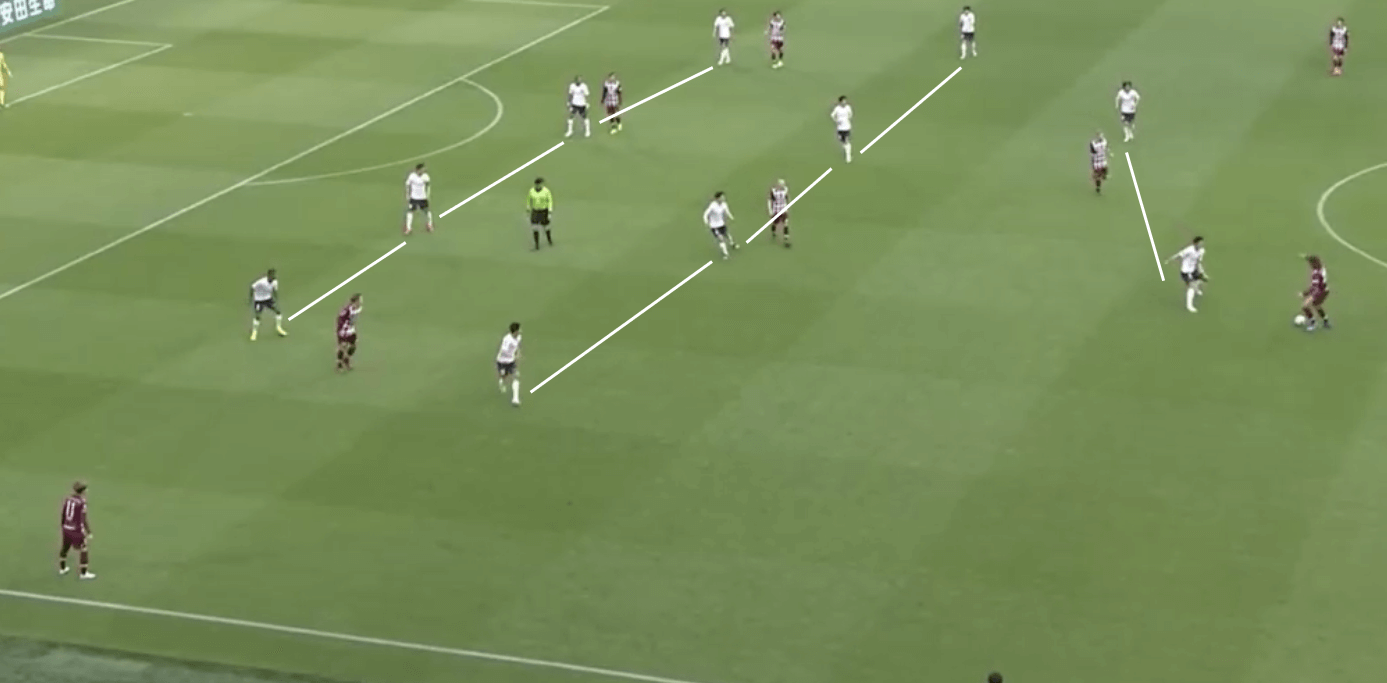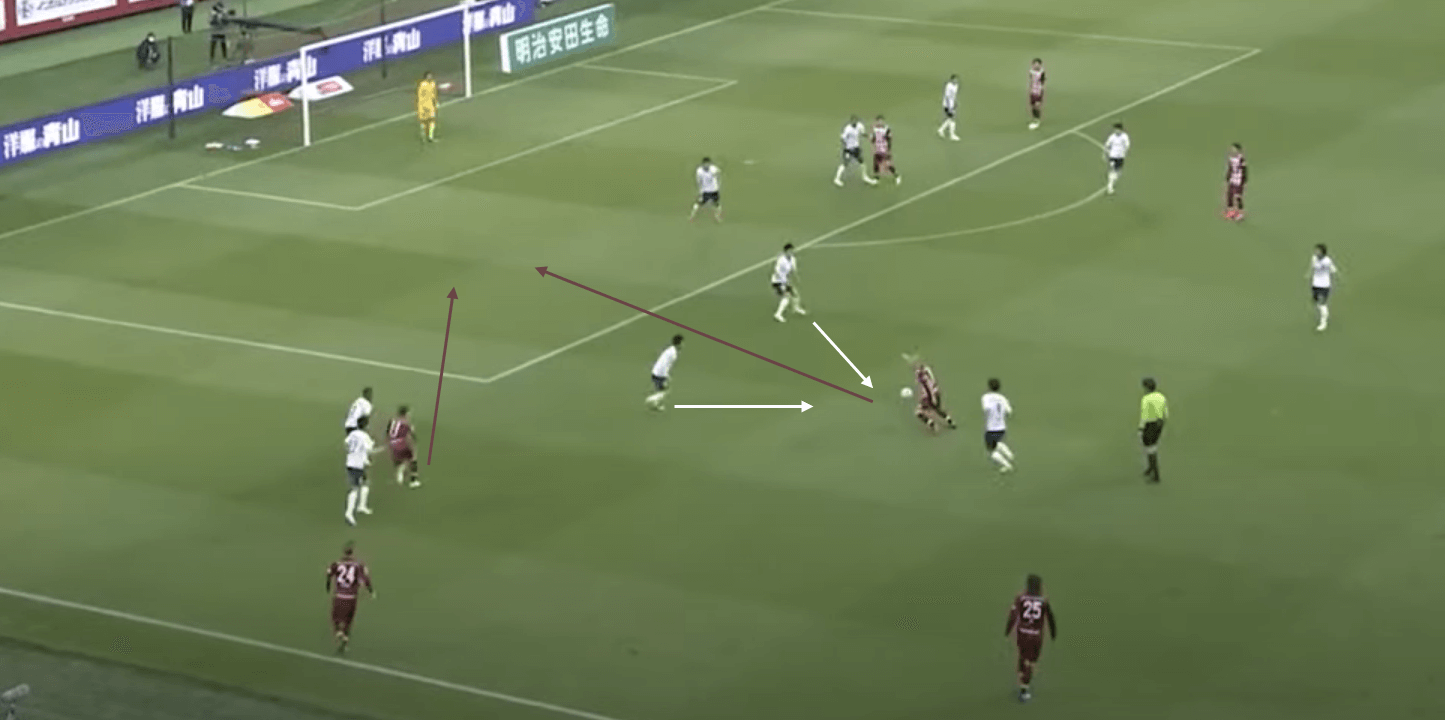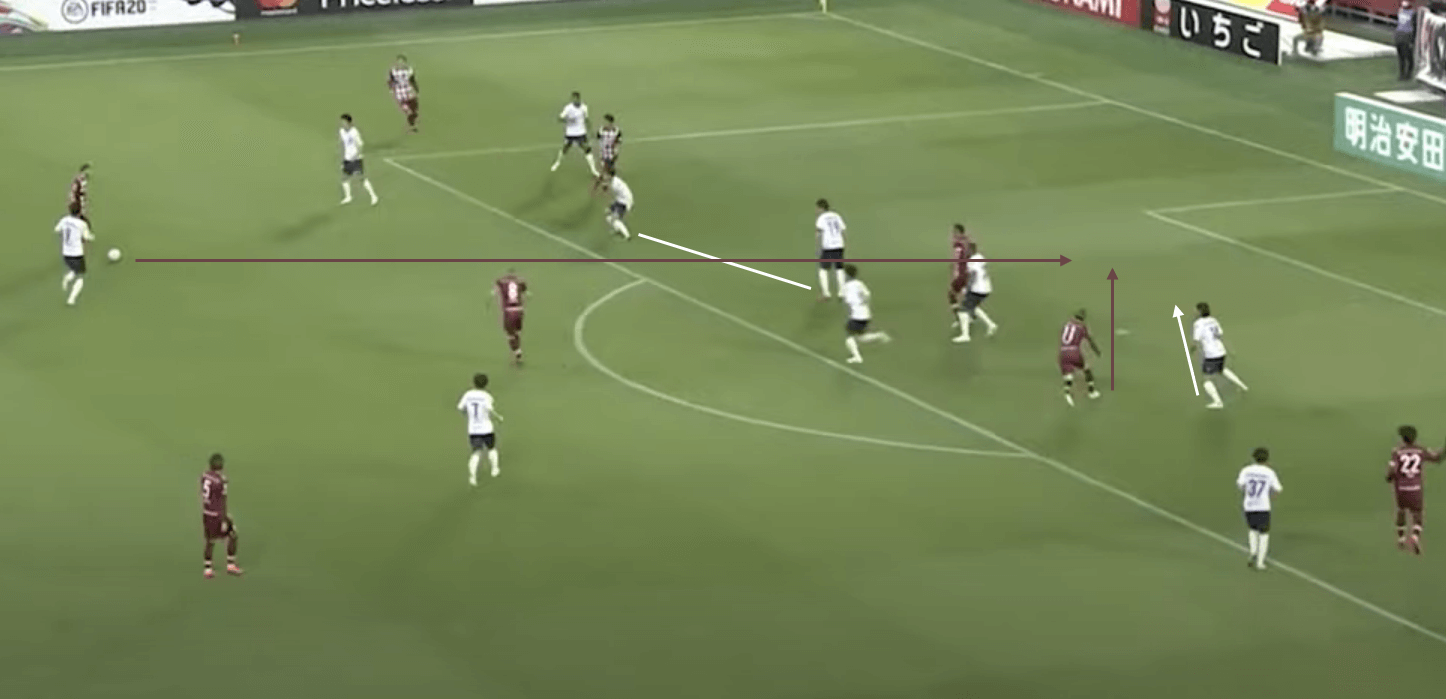Over the upcoming 2020 J1 League season, a side which will be interesting to observe is that which was promoted as J2 League runners up last season, Yokohama FC. Takahiro Shimotaira’s side picked up an impressive 79 points en route to their second-place finish and promotion in 2019.
So, having been in the J1 League for only one season previously in 2007, when they were relegated after one season having being champions of the J2 League the year previous, Fulie will be hoping to fare better this time around.
A tie against Vissel Kobe in the opening game of the season did not offer as the ideal fixture to make a comeback in Japan’s top division, however, the Yokohama side gave a good account of themselves and picked up a 1-1 draw.
So, this tactical analysis will dissect the key tactics of Yokohama FC that were on show in the opening league game of the season. The scout report will also use analysis to show how these tactics will play a key feature over the remainder of the season.
Overlapping full-backs
While Fulie were attacking against Vissel Kobe in the opening game of the season, overlapping full-backs were a prominent feature to any attacking success they had. In the 4-4-1-1 system which Shimotaira deployed in their first J1 League match for around 12 seasons, this tactic was vital in helping the away side create overloads where possible.

As can be seen in this annotation, from early in the game against Andres Iniesta’s Vissel Kobe, when the opportunity arose the full-backs would make quick overlapping runs. In this instance, as soon as Yusuke Matsuo has received possession of the ball, Takaaki Shichi has sensed the opportunity and made the overlapping run.

As can be seen in this instance later in the game, the overlapping run of the full-backs paid dividends in Yokohama opening the scoring. In the annotation, a similar pattern of play has occurred to the previous image and Shichi has received possession beyond Matsuo. The Japanese defender is then able to get to the byline and his cross eventually falls to the feet of Tatsuki Seko who fires home.
Yokohama’s single pivot
Having taken the lead inside 25 minutes against the J1 League stalwarts, Vissel Kobe, the away side had to rely on the strength of their defensive play to take something from the game. A key feature of that defensive play was the role which was performed by Kohei Tezuka. As seen with many J1 League sides in the opening game of the season, Yokohama deployed a single pivot which was vital to the team.

As can be seen in this image, with Fulie out of possession and the attacking midfielder – Shunsuke Nakamura – having dropped into the midfield four, Tezuka then drops deeper. From here, the Japanese midfielder is able to drop deeper into the defence if the side comes under greater pressure or step further forward into midfield if the side regains possession.

As can be seen here, Tezuka is performing the second main role of a pivot. This key role for a pivot is to support the defence while in possession and attempt to bridge the gap between the defenders and the midfielders. As can be seen here, with Yuji Rokutan in possession, Tezuka has dropped deep to pick up the ball and help the side to play through the thirds and retain possession.
As mentioned, many J1 League sides deployed a single pivot in the opening game of the season and Tezuka was essential in the clash with Vissel Kobe for helping to start attacks and also maintain solidarity when out of possession. During the tie, Tezuka completed more passes than any of his teammates with 33 and it seems likely that Tezuka’s role will be a prevalent feature over the season.
Two solid banks of four
As mentioned in the previous section, when Nakamura would drop into midfield Tezuka would drop deeper, however, more often than not the Yokohama side would maintain two solid banks of four to maintain their defensive strength. In the clash with Vissel, Yokohama FC made 48 interceptions and 33 clearances, both which were made possible by this out of possession shape.

This rigid defensive structure of 4-4-2 when out of possession can be seen here. The lines are compact laterally and longitudinally and that will have helped Shimotaira’s side make so many interceptions as the side were difficult to play through. Coupled with Tezuka dropping deeper when required into the gap between the defence and midfield, Yokohama were able to prevent Vissel equalising until late in the game.
The tactic feels as though it will be a key feature for Yokohama over the season as it is likely that they will be labelled as underdogs for many ties having been promoted from the league below last season. So, it seems that Shimotaira may favour 4-4-2 or 4-4-1-1 over the 4-2-3-1 which he has previously shown a preference for as the former two make this out of possession shape easier to transition into.
Lacking defensive awareness
While Yokohama’s rigid structure allowed them to remain compact and solid for the majority of the game, it was their defensive awareness which was occasionally lacking which let them down. With Vissel Kobe having enjoyed 70% of the possession and made 690 completed passes, far more than Yokohama’s 255 completed passes, Fulie became stretched at times.

As can be seen in this annotation, when Yokohama did not stick to their rigid 4-4-2 out of possession shape, Vissel were able to cause them problems; especially with Iniesta pulling the strings. In this instance, with the Spaniard in possession of the ball, two defending players are lured into closing him down, this then opens a large gap in the defence and Vissel Kobe almost equalise due to this defensive lapse in concentration.

Here, the build-up play to Vissel Kobe’s equaliser can be seen. With the game reaching its final 15 minutes, tired defensive legs are likely developing and the lateral compactness which had allowed the away side to remain so solid was starting to become relaxed. With the gap in the defence wide open, Sergi Samper slots the perfect through ball to Kyogo Furuhashi who levels the scores.
This lack of defensive awareness at times could end up proving costly for Yokohama FC if they do not work on their concentration and stick to their solid 4-4-2 shape when out of possession. It is fair to say that with 16 shots of which only six were on target, Vissel were a little wasteful and Yokohama FC must improve in this area over 2020 if they are to avoid a repeat of the 2007 J1 League season.
Conclusion
It seems likely that Takahiro Shimotaira will have been delighted that his side was able to pick up a point in what was a tough away fixture for the opening game of the 2020 J1 League season. Vissel Kobe finished eighth in the Japanese top division last season, so, the point is by no means a poor one.
Fulie have their attacking strengths in their overlapping full-backs and are able to retain defensive solidarity through the use of a pivot and their out of possession structure, however, their defensive awareness must improve if they are to claim the season has been successful by its close.
This tactical analysis has dissected three key tactics of Yokohama FC and highlighted a potential weakness in their play. The scout report has also used analysis to show how those tactics could be essential over the remainder of 2020.





Comments